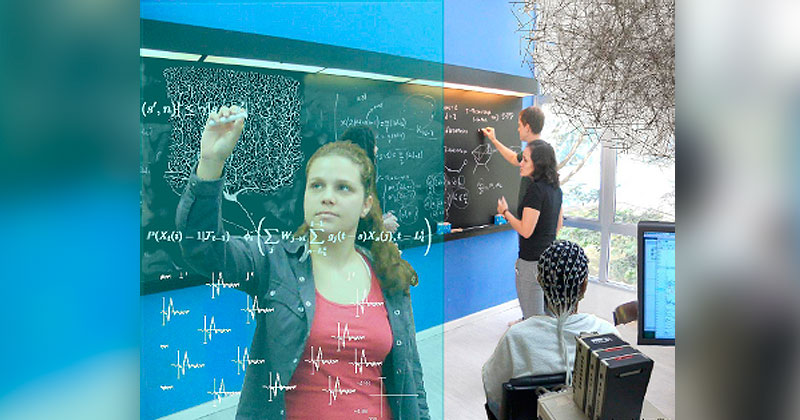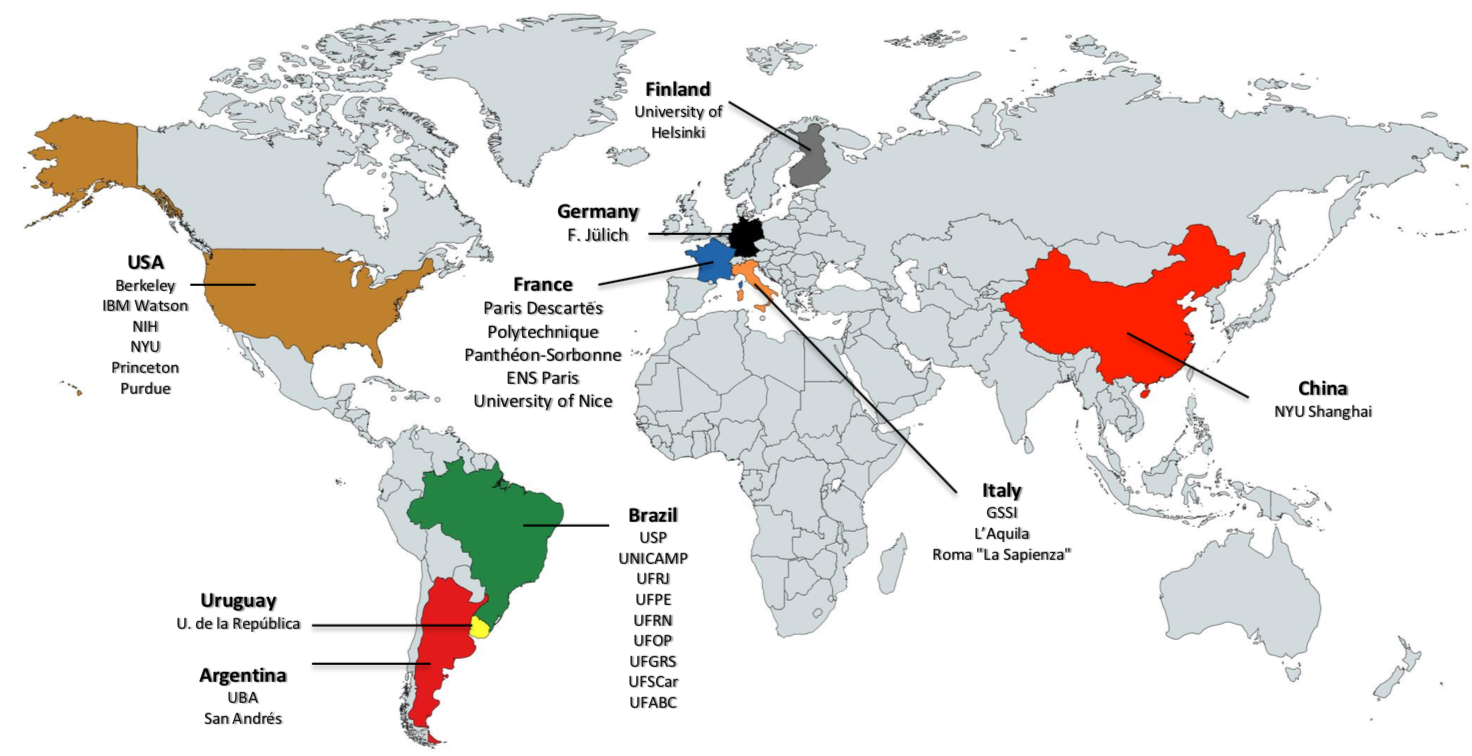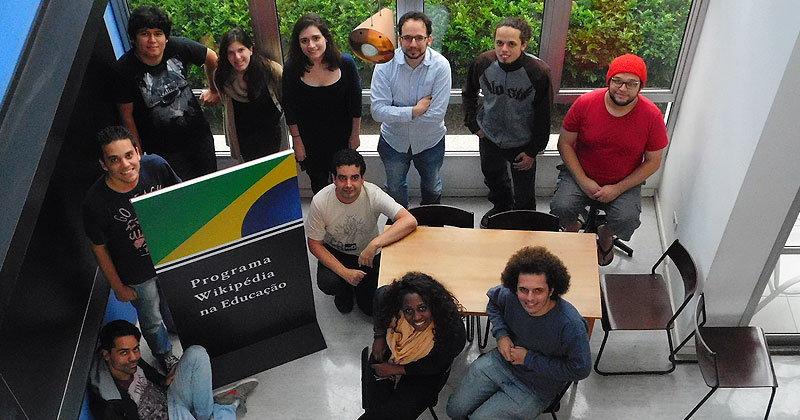The Research, Innovation and Dissemination Center for Neuromathematics (RIDC NeuroMat) has worked to develop the new mathematics needed to construct a Theory of the Brain accounting for the experimental data gathered by neuroscience research

The study of the brain is probably the most important research topic of our times. An evidence of this claim is the concomitant worldwide creation of brain initiatives, including the BRAIN Initiative (USA, 2013), Human Brain Project (Europe, 2013), Brain/MINDS (Japan, 2014) and China Brain (China, 2016). FAPESP’s decision in 2013 to create the Research, Innovation and Dissemination Center for Neuromathematics (RIDC NeuroMat) spearheaded this direction of study.
The distinctive feature of NeuroMat in comparison with other initiatives is its emphasis on the development of a new mathematical framework to address the challenges raised by contemporary neurobiology. This feature goes along with the criticism that the Nobel prize laureate Edvard Moser raised against the Human Brain Project, which applies to other initiatives as well: “As I understand it, tons of data will be put into a supercomputer and this will somehow lead to a global understanding of how the brain works, but to simulate the brain, or a part of the brain, one has to start with some hypothesis about how it works. Until we at least have some well-grounded theoretical framework, building a huge simulation is putting the cart before the horse”. The goal of the RIDC NeuroMat is the development of this theoretical framework. This pioneer initiative by FAPESP’s RIDC NeuroMat puts São Paulo at the forefront of worldwide research in neuroscience.
The RIDC NeuroMat is a center of mathematics whose mission is to develop the new mathematics needed to construct a Theory of the Brain accounting for the experimental data gathered by neuroscience research. The long-term objective is to understand and explain complex neuroscientific phenomena, with focus on learning and memory. Neuromathematics is envisioned, at this time, as conjoining probability theory, statistics, and neuroscience. This requires the definition of a full new class of mathematical models to describe and explain in a parsimonious way the different scales of neural activity, their relationship and behavioral consequences. The construction of these models occurs together with the development of novel statistical and computational methods.

NeuroMat has fostered and leads a worldwide network (Brazil, Argentina, China, Finland, France, Germany, Italy, Uruguay, and USA) of over fifty mathematicians, neuroscientists, computational scientists, applied statisticians and clinicians. Since its inception in 2013, the NeuroMat team produced 261 articles, which have been cited 1,236 times.
The international and multidisciplinary research network built by NeuroMat was made possible within the long-term support framework provided by FAPESP’s conception of the RIDCs, aiming at cutting-edge knowledge in scientific research, innovation and dissemination.

A main scientific achievement was the introduction by the NeuroMat team of a new class of stochastic processes aimed at a realistic description of nets of spiking neurons. These processes are systems with infinitely many interacting chains with memory of variable length. Since their introduction, these stochastic processes have become part of the research agenda of several centers in the world.
Our contributions to the investigation of this new class of stochastic processes include:
- the identification of mathematical conditions assuring the existence of the processes together with the design of a perfect simulation algorithm for their numerical implementation;
- results on the hydrodynamical limit of processes belonging to the class. This is an important step to relate different scales of description of the system, from the microscopic level, modelling systems of spiking neurons, to the mesoscopic and macroscopic levels, describing EEG and fMRI data;
- existence of phase transition for a specific instantiation of these models with leakage, setting a new framework for the rigorous investigation of spontaneous transitions of brain activity states, e.g. healthy to seizure-like activity. This is the first phase transition result rigorously proved for a mathematical model describing a system of interacting spiking neurons;
- introduction of a novel estimator of the interaction graph for models in this class and the proof of its strong consistency, not requiring the usual assumptions of stationarity and uniqueness of the invariant measure. This contribution addresses an important issue in contemporary neurobiology, namely the question of how to infer neural interactions from the activity of an ensemble of neurons.
A second major achievement is the introduction of a new mathematical approach to address the classical conjecture that the brain retrieves statistical regularities from sequences of stimuli. This approach is based on a new class of stochastic processes, namely sequences of random objects driven by chains with memory of variable length. These processes appear as good candidates to model the relationship between sequences of stimuli and sequences of suitably parsed brain signals and behavioral states registered while exposed to stimuli.
This framework offers a new way to model structural learning and memory in the brain, including the following promising directions of research:
- It provides an effective way to identify brain sensitivity and reaction to sequences of stimuli which goes much beyond the possibilities offered by current averaging-based methods;
- As a consequence, it allows the introduction of a entire new class of experimental protocols in which physiological or behavioral data are recorded while a volunteer is exposed to sequences of stimuli generated by a stochastic chain with memory of variable length;
- This approach offers promising perspectives in clinical neuroscience by identifying different signatures in response to structured sequences of stimuli in neurological disorders;
- From a purely statistical point of view, sequences of random objects driven by chains with memory of variable length constitute an innovative tool in functional data analysis and high dimension statistics.
Innovation and Technology Transfer
The innovation mission of the RIDC NeuroMat is to develop tools and applications based on the new conceptual framework to understand the brain.
- A spin-off of the new class of experimental protocols devised by NeuroMat is the Goalkeeper Game, an open-source, online game with desktop and mobile device versions, which provides an efficient tool for massive data collection. The game is freely available at: game.numec.prp.usp.br and also at Apple Store and Google Play.
- The Goalkeeper Game has potential to be used as an early assessment and rehabilitation tool in neurology, and the NeuroMat technology transfer team is currently testing its applicability in two current clinical development fronts: Parkinson’s disease and brachial plexus injuries. Preliminary studies showed that the game has higher predictive power than the Montreal Cognitive Assessment (MoCA) test for gait performance in people with Parkinson’s disease.
- NeuroMat developed two new neuro-rehabilitation and diagnosis initiatives directed towards Parkinson’s Disease (AMPARO) and Brachial Plexus Injuries (ABRAÇO).
- NeuroMat developed the Neuroscience Experiments System (NES), a free, online opensource user-friendly computational platform to assist researchers in data and metadata collection and experiments management. Up to now NES has supported 22 experiments, managing data of around 500 subjects.
- Recently, NeuroMat launched the NeuroMat Open Database (https://neuromatdb.numec.prp.usp.br). This is a repository of data and metadata collected within NeuroMat providing free online access to the stored data.
- Our group has pioneered the use of word graph analysis for computational phenotyping in psychiatry, neurology and education. Word graphs provide a fast and low-cost tool to quantify psychopathological symptoms previously accessible only through qualitative examination of specialists.
Dissemination
NeuroMat’s activities in science dissemination use innovative means to transform scientific culture, overcoming artificial field boundaries and contributing to foment an integrated and genuinely multidisciplinary approach to the study of the brain.

- NeuroMat has become a global player in digital dissemination science. It is the world leading institutional producer of mathematics content on Wikipedia and the pioneer of the Wikipedia Year of Science in Latin America.
- Content on Wikipedia produced by or with the support from the NeuroMat dissemination team has been viewed by 22 million people since 2014. In the same period, 14.3 million words were added on Wikipedia in the context of the NeuroMat Wikipedia Initiative.
- NeuroMat has contributed 9,911 media files to the Wikimedia Commons, the repository of images and videos that feeds Wikipedia. This content was viewed 10.4 million times in August 2018 alone.
- NeuroMat has established partnerships with museums to share their collections on the internet, particularly the University of São Paulo Museu do Ipiranga, Museu de Anatomia Veterinária and Matemateca. This has been featured as a key activity of preserving cultural knowledge, especially in the context of the fire at the Museu Nacional, in Rio de Janeiro. NeuroMat’s line of action with museum has also led to creating a special exhibition on brain biology at the Museu de Anatomia Veterinária (30,000 visitors every year) and to devising a project of the Statistician Brain exhibition at USP’s Parque CienTec.
Fostering a new generation of researchers
NeuroMat is strongly committed to training young researchers. The young scientists formed at the center come from different scientific backgrounds and countries. This diversity fosters a genuine multidisciplinary team and a research practice that is necessary for the development of contemporary neuroscience.
NeuroMat has become the organizer of the Latin American School on Computational Neuroscience (LASCON), which is the first and most important school of computational neuroscience in Latin America.
Fifty-five young researchers have been trained at NeuroMat since its inception, in 2013. The team of young researchers the RIDC NeuroMat has trained includes: 10 technical training fellows, 13 postdoctoral researchers, 18 PhD candidates, 7 Master students and 7 scientific journalism fellows. These researchers have worked on probability theory, statistics, simulations, software development, neurobiology and dissemination.
